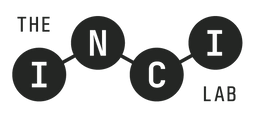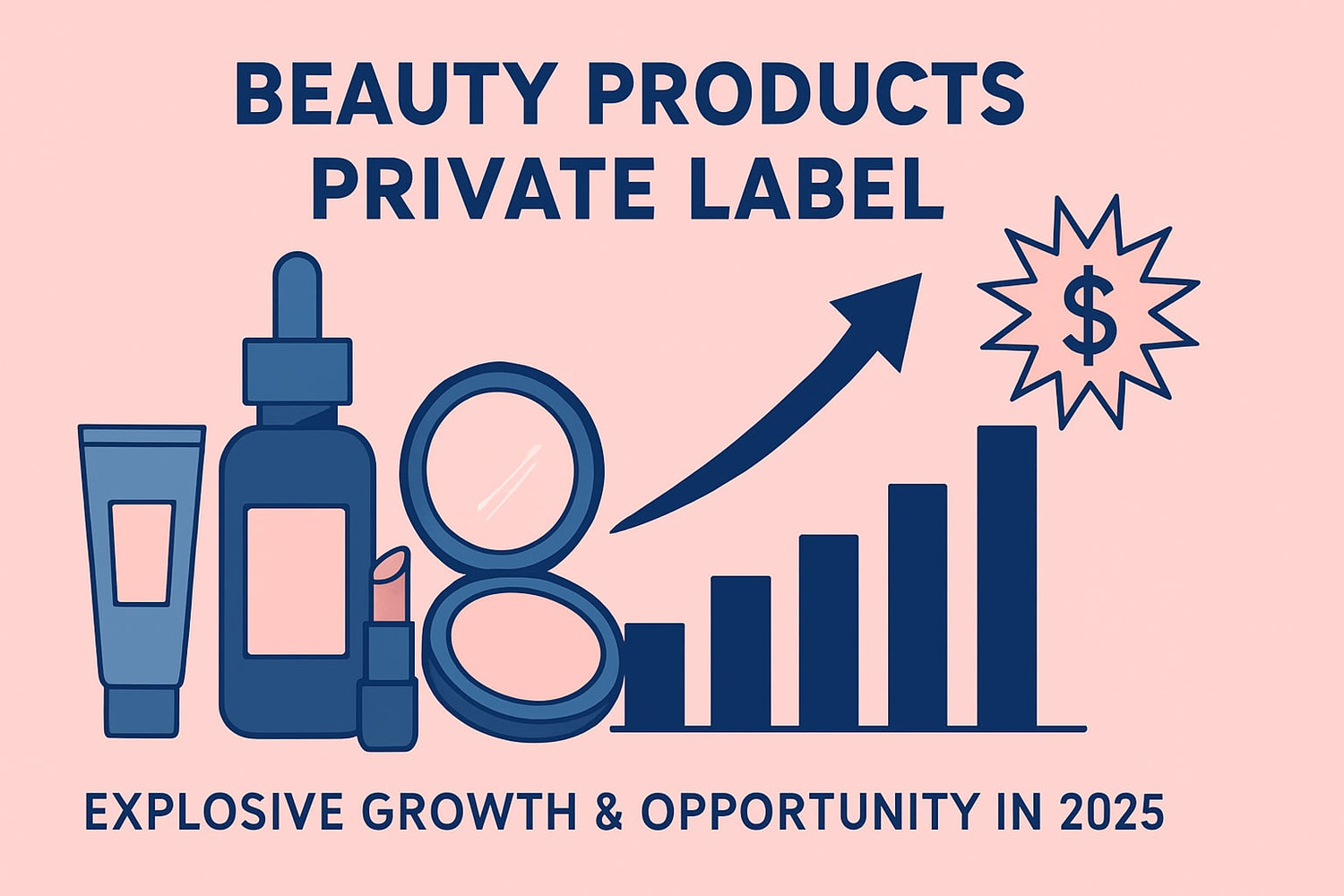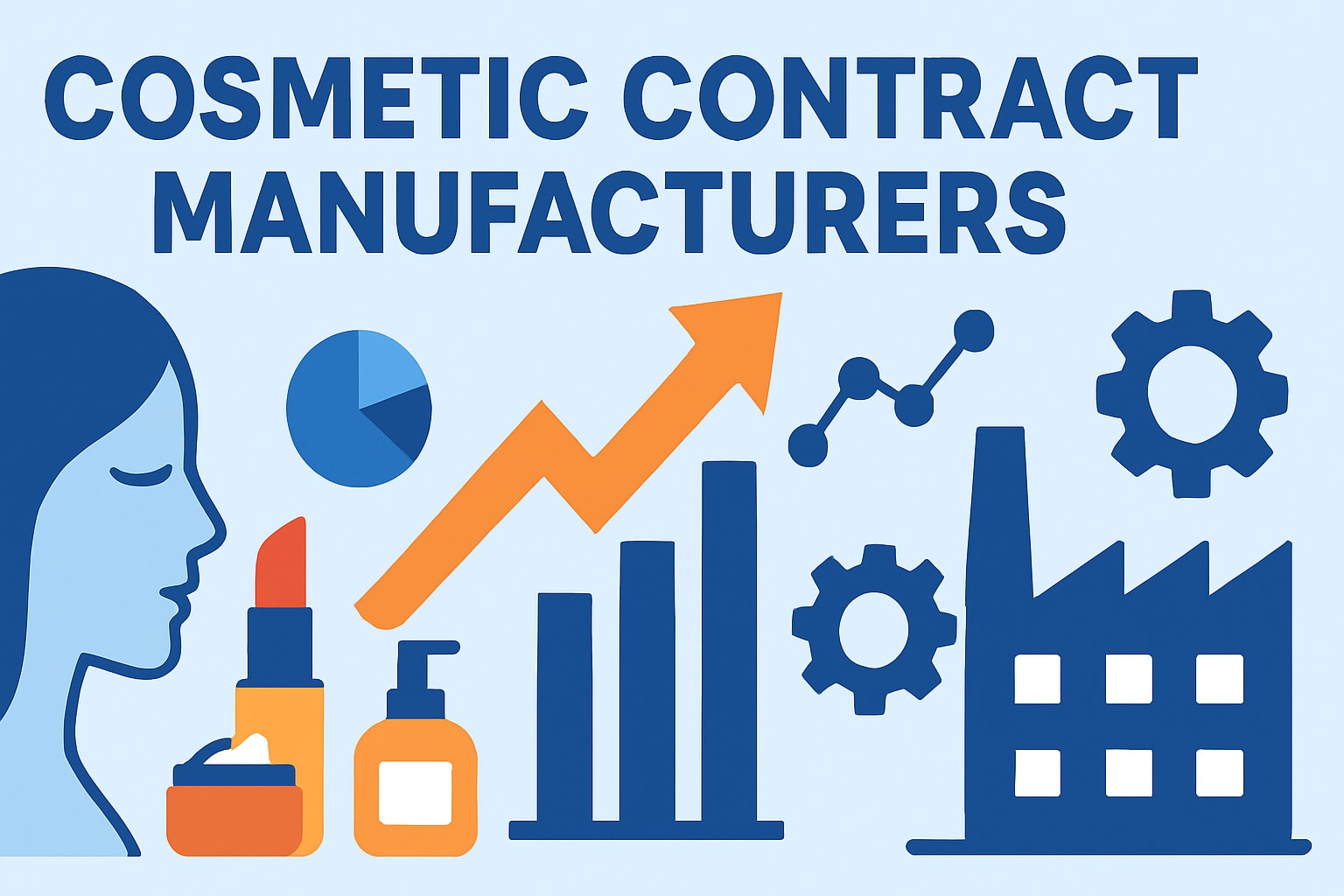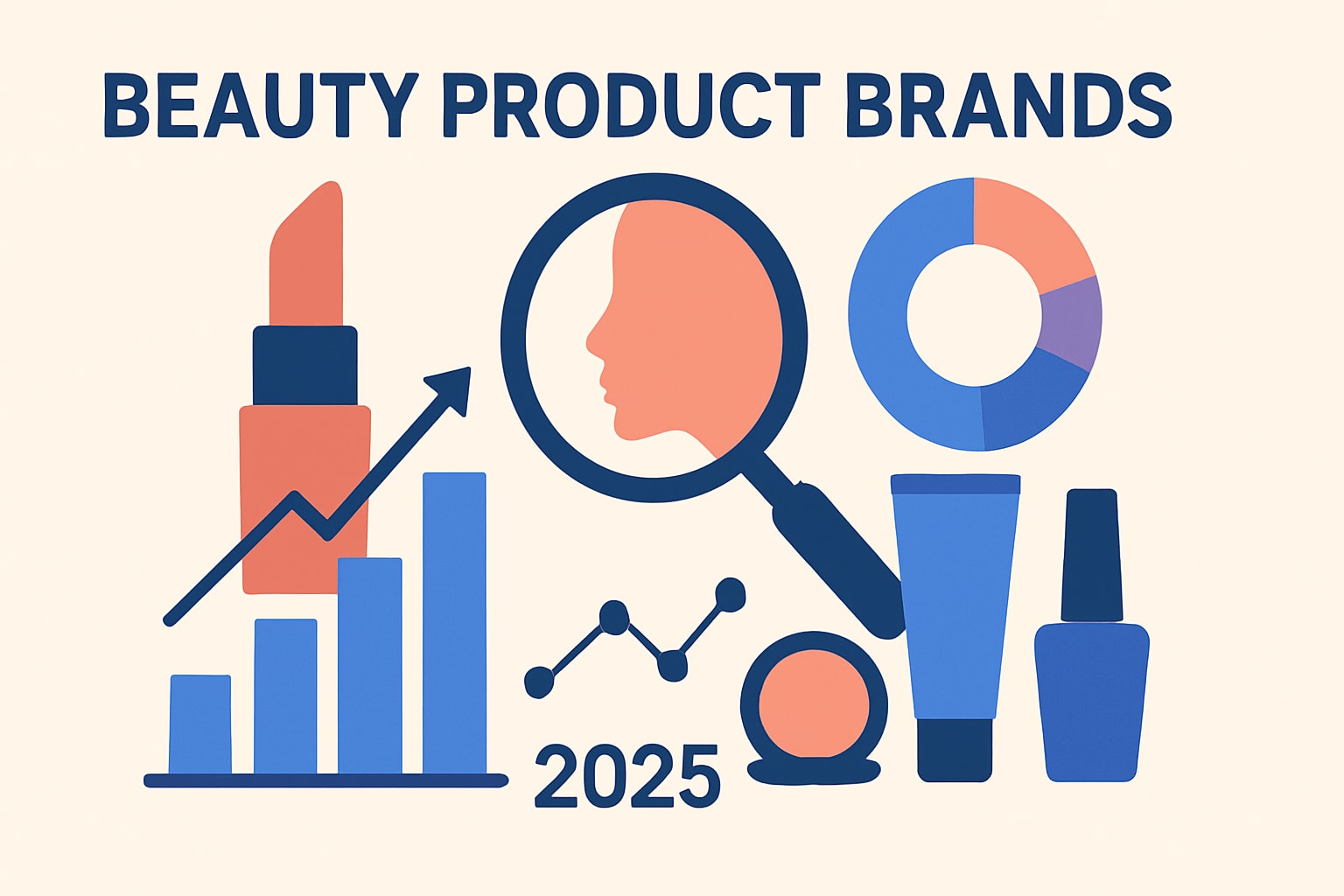The beauty products private label market is surging, set to help drive the global beauty industry to $580 billion by 2025. Entrepreneurs and businesses are seizing this momentum, using private label models to unlock faster launches, better margins, and unique brand identities.
This guide is your comprehensive roadmap to building a successful beauty brand in the evolving 2025 landscape. We cover everything you need, from understanding the private label model and spotting top trends, to choosing suppliers, developing products, ensuring compliance, and executing standout marketing.
Ready to control your product line and stand out in a competitive market? Follow this step-by-step guide to turn your beauty brand vision into a thriving reality in 2025.
Understanding Private Label Beauty Products
Navigating the world of beauty products private label offers an exciting opportunity for brands to stand out. This section explores what private label means in the beauty industry, highlights key 2025 trends, weighs the pros and cons, and helps you decide if this model fits your business.
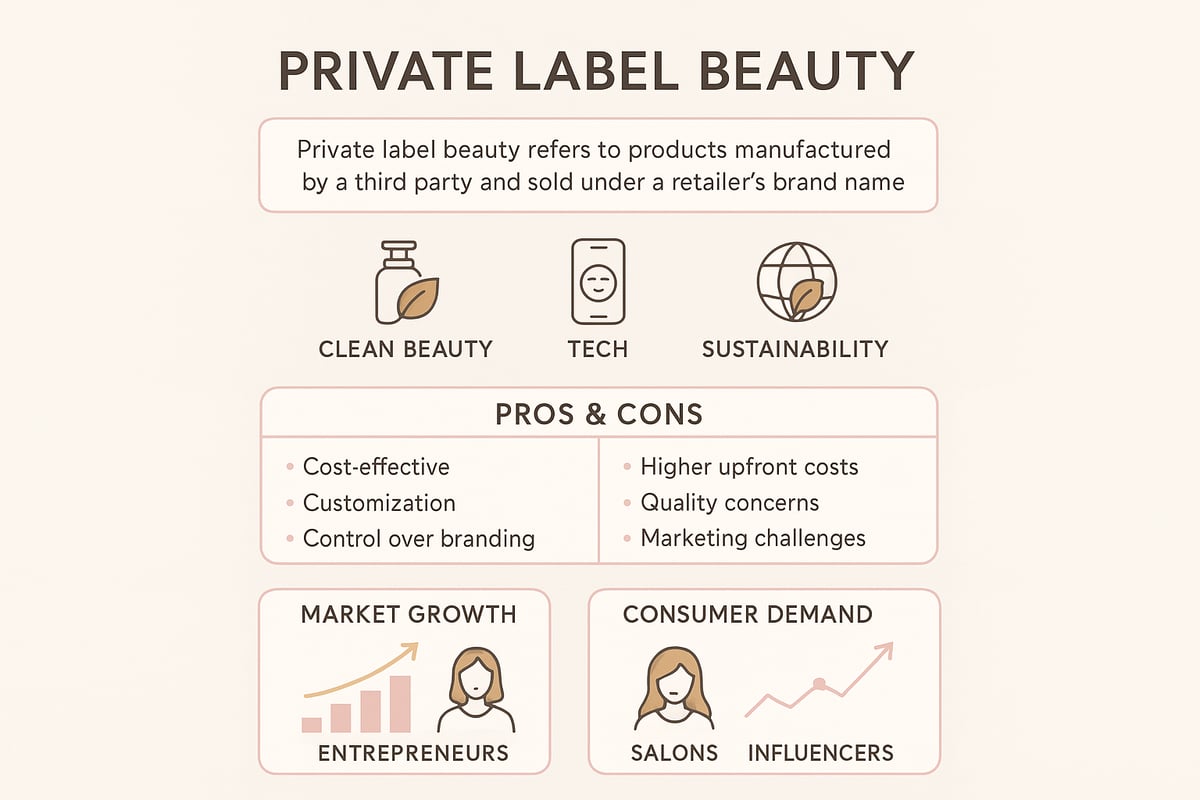
What Is Private Label in Beauty?
Beauty products private label refers to goods produced by a manufacturer and sold under another company's brand. Unlike white label, which offers generic, ready-to-market formulas, private label allows more customization in formulation, packaging, and branding. Contract manufacturing typically involves even greater collaboration and unique product development.
The advantage of beauty products private label is speed to market, lower development costs, and the ability to tailor products. Brands like Kylie Cosmetics and The Ordinary have found success using this model. Common categories include skincare, makeup, haircare, and body care. Startups and established brands both benefit, especially as consumers increasingly seek niche and indie brands.
Key Market Trends for 2025
Emerging trends are reshaping the beauty products private label landscape. Clean beauty, sustainability, and ethical sourcing are now fundamental. Brands are personalizing ranges to embrace inclusivity, while AI and AR technologies power digital try-ons and product recommendations.
The demand for vegan, cruelty-free, and eco-friendly products is surging. Regulatory changes impact formulation and labeling, so brands must stay agile. According to the 2025 Beauty Trends Report, private label beauty is growing rapidly, with top-performing brands adapting quickly to these shifts. Case studies show that brands leveraging these trends see increased loyalty and market share.
Pros and Cons of Private Labeling
Choosing a beauty products private label strategy offers clear benefits and challenges. Consider the following:
| Pros | Cons |
|---|---|
| Brand control | Minimum order quantities |
| Higher profit margins | Limited formulation flexibility |
| Faster to market | Supplier reliability risks |
| Flexibility and scalability | Ingredient shortages |
| Lower development costs | Market competition, differentiation |
Risks include quality assurance and intellectual property protection. However, brands that differentiate through unique ingredients or branding can thrive. Examples show that careful supplier vetting and a strong brand identity help avoid common pitfalls.
Who Should Consider Private Label Beauty?
The beauty products private label model suits a variety of businesses, including:
- Entrepreneurs entering the beauty sector
- Salons and spas expanding their offerings
- Influencers launching personal brands
- Established brands testing new concepts
Consider this checklist:
- Do you have a clear target audience?
- Is your budget sufficient for minimum orders and marketing?
- Can you commit to brand development and compliance?
With the right approach, beauty products private label can support various business models, from boutique lines to large-scale launches.
Step 1: Research and Define Your Beauty Brand
Building a successful beauty products private label brand starts with thorough research and clear definition of your business vision. This foundational step helps you stand out in a crowded market, ensures compliance, and sets you up for growth.
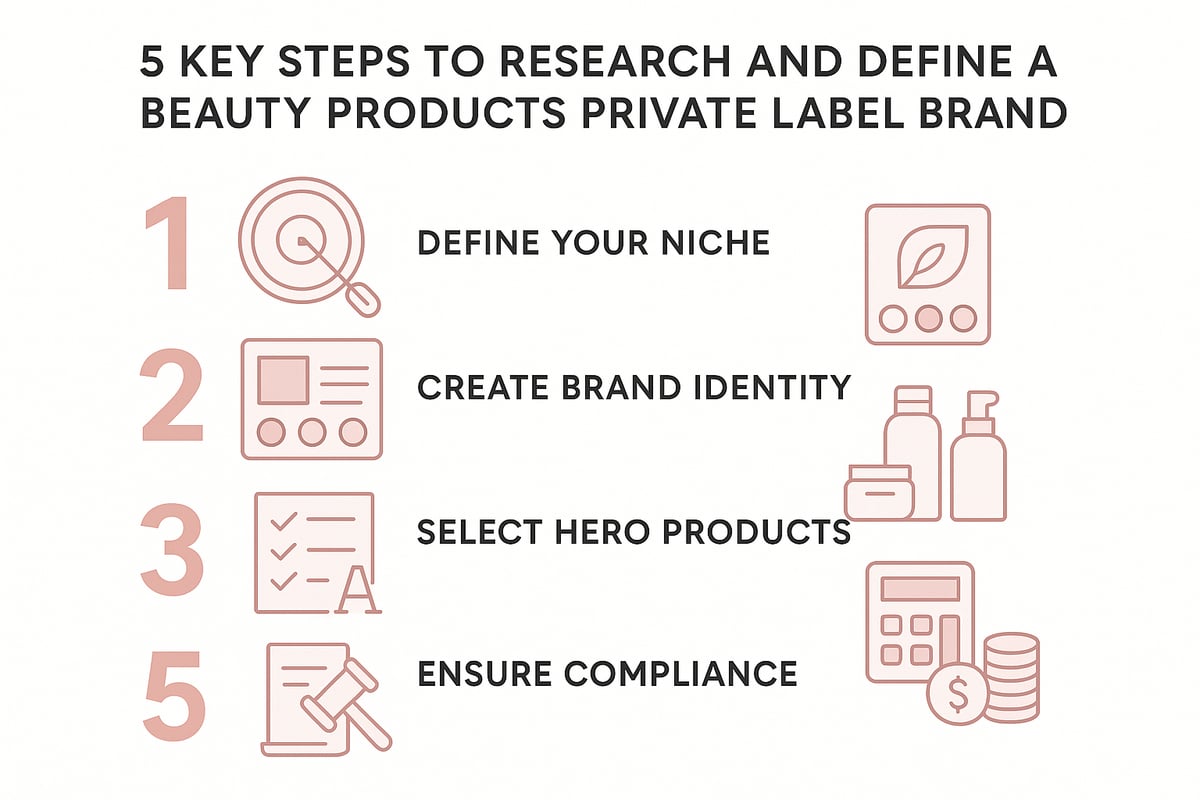
Identifying Your Niche and Target Market
Choosing the right niche is vital for your beauty products private label success. A focused niche lets you address specific consumer needs and reduce direct competition. Start by identifying gaps in the market using tools such as Google Trends, social listening platforms, and competitor analysis.
Look at trending categories like clean beauty, K-beauty, men’s grooming, or inclusive cosmetics. Build a detailed profile of your ideal customer, considering demographics, psychographics, and buying behavior. Analyze competitors to spot what they are missing, then position your brand to fill those gaps. Data shows that niches like vegan skincare and personalized products are top performers for 2025.
Crafting Your Brand Identity
A strong brand identity sets your beauty products private label apart and builds customer loyalty. Define your mission, values, and brand story. Visual branding elements like your logo, color palette, and packaging design should all reflect your vision and appeal to your target audience.
Decide on your tone of voice and key messaging. Will you position yourself as a luxury, clinical, or affordable brand? Consistency across all touchpoints is essential. For actionable steps on building your own brand identity and launching, see this guide on Creating Your Own Skincare Brand.
Product Selection Strategy
Selecting the right products is a critical part of your beauty products private label plan. Decide if you want to launch with a hero product or a full collection. Analyze market demand, profitability, and seasonal trends before committing.
Gather inspiration from bestsellers, influencer favorites, and consumer feedback. Test and validate product ideas with small focus groups or samples. Balance innovation with practicality, ensuring you can deliver what customers want. Popular private label categories for 2025 include serums, cleansers, and multi-tasking products.
Regulatory and Compliance Considerations
Every beauty products private label brand must comply with regulations in its target markets. Research cosmetic regulations for the US, EU, and Asia, focusing on ingredient restrictions and required safety testing.
Make sure your labels meet INCI standards and include all necessary claims, warnings, and allergen disclosures. Pursue certifications like cruelty-free, vegan, or organic if they align with your brand. Stay informed about regulatory updates and consult resources or legal experts to avoid costly mistakes. Learning from case studies of compliance failures can help you avoid common pitfalls.
Budgeting and Business Planning
Sound financial planning underpins every beauty products private label launch. Estimate startup costs, including formulation, packaging, and marketing. Factor in minimum order quantities and inventory needs to avoid overstocking or shortages.
Set clear pricing and profit margin targets. Build a comprehensive business plan outlining your vision, goals, and key milestones. Explore funding options such as self-funding, investors, or crowdfunding. Use cash flow management strategies to keep your operations smooth. For reference, a sample budget might include costs for R&D, packaging design, website setup, and initial marketing campaigns.
Step 2: Find and Vet Private Label Suppliers
Finding and vetting the right suppliers is a critical step in the beauty products private label journey. The quality, reliability, and partnership you establish now can define your brand's success for years to come. With a rapidly evolving global supply chain, knowing where and how to look is essential for building a resilient beauty business.
Where to Find Reliable Suppliers
To launch a successful beauty products private label brand, start by identifying trustworthy suppliers. Explore online directories like Alibaba, ThomasNet, and BeautyTrade for a broad overview of manufacturers. Attending industry trade shows and networking events can connect you with experienced suppliers and offer firsthand insight into their capabilities.
Referrals from industry peers are invaluable, as are thorough background checks into manufacturer track records and client reviews. Compare domestic and international suppliers, weighing factors such as shipping times, communication, and compliance. Watch for red flags like inconsistent communication or lack of certifications. For a comprehensive guide on supplier selection, see Choosing Cosmetic Manufacturers.
Evaluating Supplier Capabilities and Quality
Evaluating the capabilities of beauty products private label suppliers requires a structured approach. Start by reviewing their product range and expertise in formulation. Request samples to test product texture, scent, and performance. Check for essential certifications like GMP, ISO, cruelty-free, and organic, which signal high manufacturing standards.
Transparency in ingredient sourcing is crucial, as is the willingness to offer facility visits or audits. Communication and responsiveness are key indicators of a reliable partner. Use a supplier scorecard to objectively compare vendors on criteria such as lead times, quality, and support. Consistent evaluation ensures you align with suppliers who uphold your brand values.
Negotiating Terms and Minimums
Negotiating with beauty products private label suppliers involves understanding minimum order quantities (MOQs), pricing structures, and customization options. Discuss formulation tweaks, packaging choices, and labeling requirements upfront. Clarify lead times and production schedules to align with your launch timeline.
Establish clear payment terms and ensure all agreements are documented in contracts. Address potential issues like price changes and raw material shortages early in negotiations. Protect your intellectual property with appropriate clauses. For startups, flexibility and transparency can often secure more favorable terms and set the foundation for a lasting partnership.
Managing Supply Chain Risks
Supply chain risks are a reality when working with beauty products private label suppliers. Diversify your supplier base to minimize disruptions from ingredient or packaging shortages. Build strong, transparent relationships to foster proactive communication during unforeseen events.
Plan for logistics challenges by maintaining buffer stock and working with reliable shipping partners. Monitor global events that could affect your supply chain, such as regulatory changes or geopolitical issues. Invest in insurance and develop contingency plans to address delays or product recalls. Real-world case studies underline the importance of agility and preparedness in maintaining brand reputation.
Working With a Custom Formulation Lab: The INCI Lab
For brands seeking to differentiate in the crowded beauty products private label market, custom formulation labs offer a strategic advantage. The INCI Lab supports brands from concept to launch, providing full ownership of unique formulations and intellectual property.
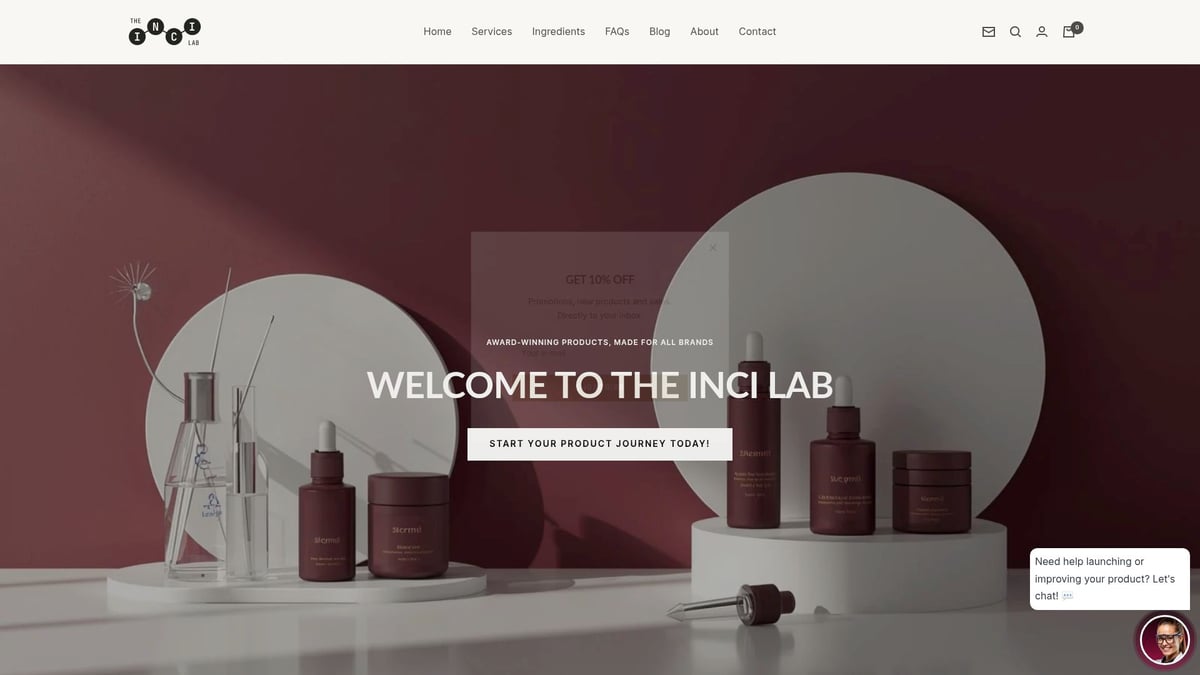
Their team specializes in eco-friendly and sustainable ingredient sourcing, ensuring regulatory compliance and innovation throughout the process. Brands receive end-to-end support, from R&D and production to packaging and market readiness. This approach is ideal for those who want high-performance, bespoke products. Real examples show how collaboration with The INCI Lab has resulted in successful, standout beauty brands.
Step 3: Develop and Customize Your Beauty Products
Developing your beauty products private label line is where your vision becomes tangible. This step involves critical decisions about formulation, design, and product quality. Each choice impacts your brand’s identity and market success. Let’s break down how to bring your unique beauty products private label brand to life.
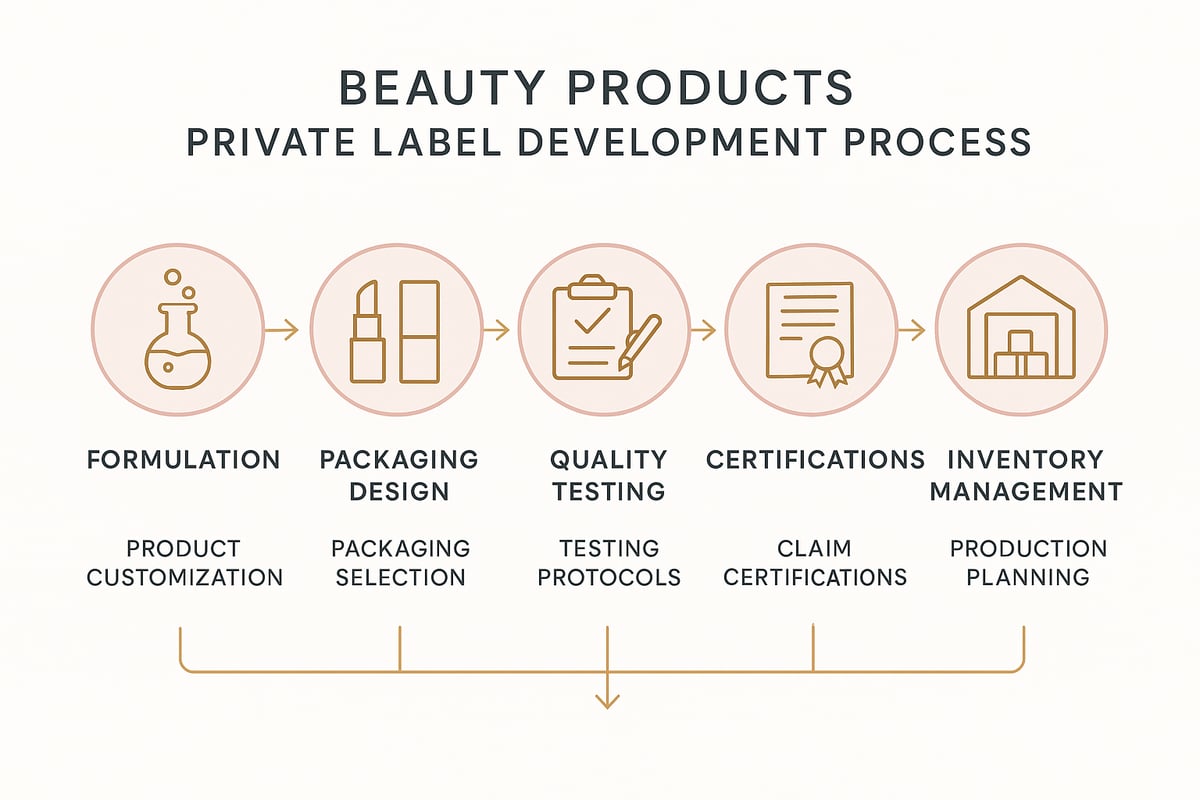
Product Formulation and Customization Options
Choosing the right formulation approach is the foundation of your beauty products private label journey. Decide whether to start with proven stock formulations or invest in custom development for a truly unique product.
Work closely with chemists to select textures, scents, colors, and active ingredients that fit your brand vision. Safety and stability testing are essential for every formula you consider. Today’s consumers seek trending ingredients, such as peptides or adaptogens, so staying up to date is crucial.
Customization offers flexibility, letting you create a hero product that stands out in the market. For a deeper dive into the rise and potential of private label skincare, read Rise of Private Label Skincare.
Packaging Design and Branding
Packaging is the first point of contact between your beauty products private label and the customer. It must reflect your brand’s personality and values, whether you choose eco-friendly, minimalist, or luxury styles.
You can select from custom or stock packaging, depending on your budget and vision. Consider packaging trends for 2025, such as refillable containers or biodegradable materials. Label design should be attractive and compliant with regulations.
A memorable unboxing experience can drive social media engagement and repeat purchases. Source reliable packaging suppliers early to avoid delays.
Testing and Quality Assurance
Quality assurance is vital for building trust in your beauty products private label. Each batch should undergo microbiological, stability, and performance testing to ensure safety and consistency.
You may also consider consumer testing or clinical trials, which add credibility to your claims. Keep detailed records for traceability and compliance. Address negative feedback promptly and use it to improve future batches.
Certifications like GMP or ISO further validate your brand’s commitment to quality. Here is a summary table of common QA steps:
| QA Step | Purpose |
|---|---|
| Batch Testing | Consistency, Safety |
| Stability Tests | Shelf Life Assurance |
| Performance | Efficacy Verification |
Finalizing Product Claims and Certifications
When marketing your beauty products private label, all claims must be accurate and legally compliant. Avoid unsubstantiated terms such as “hypoallergenic” or “clean” unless backed by evidence.
Obtain relevant certifications, like cruelty-free or organic, to appeal to conscious consumers. Third-party testing can strengthen your claims and protect your brand from regulatory issues.
Stay up to date with changing regulations and update your marketing materials as needed. Transparent communication builds consumer trust and helps your products stand out in a crowded market.
Preparing for Production and Inventory Management
Efficient production planning is essential for a smooth beauty products private label launch. Determine batch sizes, reorder points, and lead times for each product.
Use inventory management tools to forecast demand and prevent stockouts. Partner with fulfillment centers or 3PLs to streamline shipping and returns.
Monitor shelf life closely, especially for products with natural ingredients. Build scalability into your operations from the start to support future growth and multi-product launches.
Step 4: Launching and Marketing Your Private Label Beauty Brand
Launching your beauty products private label brand in 2025 requires a strategic approach to stand out in a highly competitive market. A successful launch combines a compelling online presence, diversified sales channels, targeted digital marketing, impactful PR, and exceptional customer service. Let’s break down each step to ensure your beauty products private label brand makes a memorable entrance and builds lasting customer loyalty.
Building an Online Presence
Establishing a strong digital footprint is essential for any beauty products private label brand. Start by creating a visually appealing e-commerce website with clear navigation and high-quality product imagery. Ensure your product pages are optimized for SEO, incorporating relevant keywords and detailed descriptions to boost discoverability.
Social media channels like Instagram, TikTok, and Pinterest play a vital role in showcasing your product range and engaging with beauty enthusiasts. Incorporate user-generated content and influencer collaborations to build trust and authenticity. According to Private Label Cosmetics Market Growth & Trends, the private label cosmetics market is set for substantial growth, making a robust online presence crucial for capturing your share of this expanding audience.
Omnichannel Sales Strategies
Diversifying your sales channels can significantly increase your brand’s reach. Direct-to-consumer (DTC) sales through your website offer full control over the customer experience. However, partnering with retailers, boutiques, and online marketplaces like Amazon, Etsy, or Walmart can broaden your exposure and credibility.
Consider participating in pop-up events, beauty trade shows, or subscription box programs to create buzz and gather feedback. Collaborate with salons and spas to position your beauty products private label line as a trusted choice in professional settings. A multi-channel strategy not only drives sales but also strengthens your brand’s resilience in a dynamic market.
Digital Marketing and Influencer Partnerships
Digital marketing is at the heart of every successful beauty products private label launch. Use paid ads on platforms such as Google, Facebook, and Instagram to target your ideal customer. Develop engaging content: tutorials, product demos, and behind-the-scenes stories to foster community and educate your audience.
Leverage influencer and micro-influencer partnerships to amplify your reach and build credibility. As highlighted in Private Label Trends 2025, today’s consumers value transparency, sustainability, and authenticity, so align your campaigns with these expectations. Track your results to refine strategies and maximize return on investment.
PR, Media, and Brand Storytelling
Crafting a compelling brand story sets your beauty products private label apart. Share your founder journey, mission, and values across your website, press materials, and social channels. Pitch your unique angle to beauty editors, journalists, and bloggers to secure media features and build credibility.
Leverage industry awards and certifications to enhance your reputation. Well-designed press kits and timely media outreach can drive buzz and attract new audiences. Effective storytelling fosters emotional connections, turning first-time buyers into loyal advocates for your beauty products private label brand.
Customer Service and Building Brand Loyalty
Exceptional customer service is a cornerstone of beauty products private label brand loyalty. Ensure seamless order fulfillment, easy returns, and prompt communication to create a positive experience. Encourage reviews and feedback to understand customer needs and improve your offerings.
Implement loyalty and referral programs to reward repeat customers and expand your reach organically. Engage your community through personalized follow-ups and active social media presence. Building meaningful relationships with your customers will ensure long-term success for your beauty products private label in a competitive landscape.
Step 5: Scaling and Evolving Your Beauty Brand
Scaling a beauty products private label brand in 2025 requires a strategic approach. As your business grows, focus on refining operations, expanding thoughtfully, and staying in tune with market shifts. This step-by-step process ensures your brand not only survives but thrives in a dynamic marketplace.
Analyzing Performance and Gathering Feedback
To scale your beauty products private label brand, data-driven decision-making is essential. Start by tracking key performance indicators (KPIs) such as sales growth, website traffic, customer retention, and product return rates.
Leverage analytics tools like Google Analytics and Shopify reports for actionable insights. Regularly collect customer feedback through surveys, reviews, and social media engagement. This feedback highlights areas for product improvement and service enhancements.
Benchmark your performance against industry standards. Use this data to iterate on product offerings, optimize marketing strategies, and ensure your beauty products private label brand remains competitive.
Expanding Product Lines and Entering New Markets
Expansion is a major growth lever for any beauty products private label business. Assess your readiness by evaluating current demand, operational capacity, and market trends. Start by launching complementary products or extending existing lines to attract new customer segments.
Research regional regulations and logistics before entering new markets, especially internationally. Consider collaborations, co-branded products, or licensing deals to accelerate expansion. Always monitor risk and adjust your strategy based on data, ensuring each new venture supports your overall brand vision.
Staying Ahead of Industry Trends
Remaining innovative is crucial for beauty products private label brands in 2025. Monitor trend reports, attend trade shows, and engage with industry publications to spot new opportunities. Invest in R&D to experiment with trending ingredients or product formats.
Adapt quickly to regulatory updates and shifts in consumer expectations, such as the demand for clean, sustainable, and transparent products. For a deeper dive into these movements, explore the Clean Beauty Trends 2025 to see how leading brands are capitalizing on them. Leverage technology like AI and AR to enhance product development and customer experience.
Sustainable Growth and Brand Reputation
Long-term success for beauty products private label brands depends on sustainable practices and a strong reputation. Build a resilient supply chain and communicate your sustainability efforts transparently to consumers. Manage your brand’s presence online and offline, responding promptly to feedback and addressing any issues.
Data shows that consumers increasingly prefer brands with genuine sustainability commitments. To stay competitive, keep abreast of Beauty Manufacturing Trends 2025 and implement best practices for simpler formulations and domestic production where feasible. Your brand’s legacy will be defined by its values, customer relationships, and adaptability.
You’ve just explored the essential steps for building a standout beauty brand in 2025—from defining your niche and brand identity to navigating supplier selection, product development, marketing, and sustainable growth. If you’re feeling inspired to take the next step and want a clear, actionable roadmap, I have something special for you. We’ve put together a comprehensive e-book that breaks down everything you need to know about launching your private label beauty line, including expert insights from The INCI Lab team. Ready to turn your vision into reality? Download Your Free E-Book and start building your brand with confidence.
